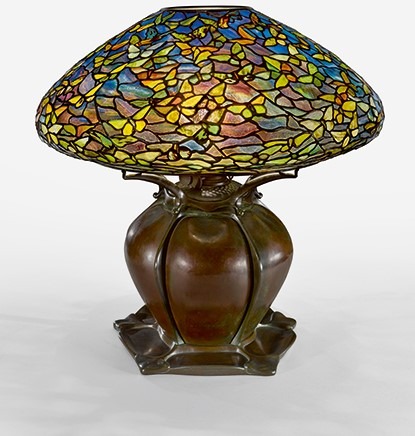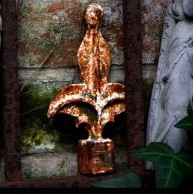Louis Comfort Tiffany – and the early 20th-century studios that bear his name – are on a roll.
There’s the Tiffany’s Glass Mosaics exhibition at The Corning Museum of Glass, the new Gallery of Tiffany Lamps at the New-York Historical Society, and a new book from Rizzoli on the Lamps of Tiffany Studio.
Sotheby’s in New York is adding more momentum to the movement. Tomorrow, June 6, the auction house will offer an extensive sampling of Tiffany Studios’ output – from leaded glass table lamps and “turtle-back” lanterns, to enameled boxes and patinated bronze favrille glass inkstands.
It’s part of a personal collection that Carol Ferranti started through her own antique business, when she opened a Madison Avenue store in 1975 across from where Tiffany’s mansion once stood. While the modernists eschewed Tiffany’s work, she was quietly snapping up the best pieces.
And Sotheby’s 38 lots are nothing short of spectacular. Take Lot 10, for example:
“There’s only one known to the marketplace, from photos published by Tiffany Studios,” says Jodi Pollack, senior vice president at Sotheby’s. “It’s a hanging wall mirror, surrounding by glass balls and candelabra – and it’s never been seen before.”
If the contents of the auction are any indicator, Ferranti was a shrewd and careful collector. “She had a private collection that she assembled in those years – and it’s so interesting and layered and evocative in her residence,” she says. “There are pictures so you can get a sense for her aesthetics and how she lived with it all.”
If there’s a common theme in the collection, it has to do with nature, like the butterfly lamp and screen and inkstand. “It’s so fascinating to see a motif expressed in different media in one collection,” she says.
Of all the lots, she’s got her eye on one piece in particular. “I would put my bet on the butterfly lamp – it’s a magical item and 20 years have passed since one appeared at auction,” she says. “It transcends being a Tiffany lamp – it’s lyrical and an early artistic production from the studio, from about 1900.”
That’s the starting point for most of the pieces at auction. The rest were produced up until about 1915.
And they’re all from a collector with an impeccable eye.
[slideshow id=1802]



